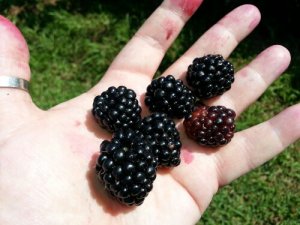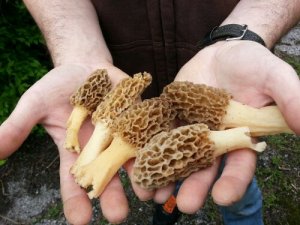Foraging is a great way to improve your diet. Many wildcrafted items are higher in vitamins, minerals and protein than domestic foodstuffs. Domestic food items are engineered to arrive in stores in viable selling condition, not be healthy, delicious and nutritious. Where foraging was once considered fringe, it is now fad.
I can’t help but find amusement in the new “foraging” craze. My family was foraging before foraging was cool. Seriously!! People used to sneer at us when they would see us turn out like a group of Capuchin monkey denuding an area of whatever resource we were there for. I can remember a few occasions really clearly when I was very small.
In 1979 the Mississippi river flooded. I was 6. I remember the whole family turning out just south of the old Clark bridge just below the old lock and dam between Alton and St. Charles County in Missouri. That area is now a national waterway and north of the new lock and dam.
When the water receded there were huge pools of trapped fish. Our dad drug us out there and my brothers and I (ok, my inclusion was limited) hand caught a ton of fish. Some other people showed up with frog gigs and we were introduced to the concept of spear fishing. We got hundreds of pounds of fish! I remember filling the trunk, feeling slimy and gross and taking it home.
We turned the backyard into a giant slaughter operation. Scaling, skinning, gutting, cutting, on and on and on until it was all processed. I remember my mother canned some of it, froze some of it…. To this day, to be honest, I don’t like fish from big rivers and there are some that I just can’t stomach no matter where they come from. I have wondered several times if it was because of this happenstance.
Another time my dad found this pear tree near his favorite donut shop. It was loaded with pears and in one of those isolated pockets of greenspace in an urban area. The whole thing was completely over grown, the tree was crazy and you had to fight your way over to it. We swarmed it and picked hundreds of pound of fruit. My mom processed a lot of them and we ate tons and tons and tons of pears. I still like pears! 🙂
My family owned 20 acres in southern Missouri (still do, actually, though I am the only person who still goes there) and I remember us finding blackberry brambles when I was around 8. We stripped it bare. Collected nuts, berries, and my dad and I hunted squirrel there for a decade.

In short, my family always foraged, just not as much as we could have. My family wasn’t as up on wild edibles as it could or should have been.
- Fruits? Yup.
- Nuts? Oh yea (I frigging hate walnuts- period. I hated hulling them and still can’t stand them).
- Fish? Check.
- Rabbit? Totally.
- Squirrel? Hell yeah!
- Berries? Uhhhhhh blackberries, grapes and wild strawberries ONLY. Everything else is poison.
- Mushrooms? Uhhhhhhh what? poison.
- Persimmons? Here eat this green one! (took a decade to try it again)
- Leafy green things? Poison.
- Anything my dad couldn’t identify? Poison.
When I was at summer camp in 1985, we had a class on wild edibles. I was introduced to the fabulous world of Wood Sorrel, Queen Anne’s lace and Morel mushrooms. Say WHAT?!?!? I became fascinated with wild edibles but had to keep it from my dad. He was a peculiar man and if it wasn’t his idea and he didn’t feel comfortable with something, it wasn’t going to happen. Period.
I started collecting field guides. I still remember my first one. It was an Audubon Guide to Eastern Trees. I got it at the clearance table at the Waldenbooks in St. Clair Square mall. Malls. Remember those?
It almost felt like a secret. I started collecting other books that were illustrative and maddening at the same time. Many of them had line drawings instead of actual photographs. I THOUGHT I knew what I was looking for, but not really sure. I didn’t start feeling confident until I had a chance encounter with someone who was an avid and experienced forager.
I got more confident. I also knew where all the fruit and nut trees in town were. Many of them were planted around professional buildings (and this was back before Roundup was everywhere) so I would take a basket and go for a walk and come home with all sorts of edibles. I was an urban forager before urban foraging was cool.
I bought my first mushroom book in 1989. Again, it was an Audubon. I was pretty good with Morels. I found an oyster tree. It reliably flushed oysters several times a year (until some jerk set it on fire and killed it). I discovered that I loved oyster mushrooms. By the time I was in my late teens I was regularly collecting urban fruits and nuts as well as wild fruits, nuts, berries, garlic, onions, some mushrooms, fish, and small mammals.

I continued to collect field guides and books about wild edibles and in my 20’s started taking classes on identification.
In my 30’s I started taking classes on mushrooms. While I in no way RELY on the foraging, we still supplement our diets quite a bit with wild foraging. My kids know about a dozen mushrooms well, several nuts, some wild greens and lots of fruit. My youngest is sort of obsessed with Paw Paws.
If you are interested in wild edibles, there are plenty of groups and forums out there. There are some REALLY excellent field guides as well. Many places offer classes in wild edibles.
You have to be careful, cautious and NEVER EVER EAT ANYTHING YOU ARE NOT 100% SURE OF!!
Be careful of urban foraging due to the widespread usage of Roundup and other chemical additives. I’m not saying don’t do it, I’m saying be careful. I will periodically post blogs about foraging.
Please do not use my photos alone for identification. There are a lot of variables to properly identifying something. Some things look very similar and the only way you can tell them apart is by the substrate they are growing off of. Here are a few things to keep in mind while you wildcraft:
- Don’t trespass. Ask first. People are often willing to let you pick things if you ask.
- Do not pick edibles near a roadway. You can assume the ground and edibles are contaminated with petrochemicals and toxins.
- Do not eat something unless you are 100% sure of it.
- Just because it is natural doesn’t mean it’s safe! Belladonna and Nightshade are natural and will kill you dead.
- If in doubt, throw it out.
- If you are wildcrafting in parks, check laws, ordinances and applicability.
- Be very careful of chemical additives from farming, Roundup is nasty stuff.
- Research the history of an area. If the park is on top of a landfill, or toxic cleanup site, don’t eat it.
- Don’t be afraid to admit you don’t know. Pride will get you dead. If you don’t know, you don’t know. Ask for help.
- Look for help! There are so many Facebook groups, blogs, groups and education centers there will be help somewhere! (just find out what their expertise is, there ARE quacks!)
Wildcrafting is fun, tasty, nutritious and a wonderful excuse to get your family outdoors.
Enjoy your journey!

Hi, your blog looks cool, but I can’t figure out how to follow you. Can I subscribe via email to a mailing list or something? Thanks
LikeLike
On the desktop version there should be a box in the bottom right hand corner that says “follow” and you can put your email address in there. On the phone version, it is right at the top inder the post heading.
I don’t write as often as I should, though.
LikeLike